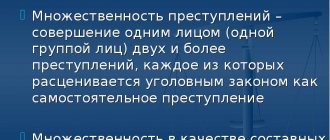Legal error
A legal error is an incorrect assessment by the perpetrator of the legal essence or legal consequences of the act committed. It is customary to distinguish the following types of legal errors:
- error in criminal law prohibition;
- imaginary crime;
- a person’s incorrect understanding of the legal consequences of the crime being committed.
Error in criminal law prohibition , i.e. an incorrect assessment by a person of the act he commits as not criminally punishable, whereas in reality it is recognized as a crime in accordance with the law. An error of this kind does not exclude intentional guilt, since ignorance of the law does not equate to a lack of consciousness of social danger and cannot serve as an excuse for a person who has committed an act prohibited by criminal law.
An imaginary crime is a person’s erroneous assessment of the act being committed as criminal, when in fact the law does not classify it as a crime. In such cases, the act does not have the properties of social danger and illegality, therefore criminal liability is excluded. For example, the “theft” of car tires discarded due to wear and tear is not criminal due to the absence of an object of attack, therefore there is no guilt in its criminal legal meaning.
A person’s misconception about the legal consequences of the crime being committed : its qualifications, the type and amount of punishment that can be imposed for committing this act. Such an error does not affect the form of guilt or criminal liability.
Subjective error and classification of crimes.
A subjective error is a person’s incorrect understanding of the objective properties of a socially dangerous act or its illegality. A legal error, which is a person’s misconception regarding the legal properties and legal consequences of the act committed, does not affect the qualification of the crime (believes that the act is not criminal and commits it - in this case there will be a crime). At the same time, if a person commits some actions that he considers criminally punishable, but they are not, there is no corpus delicti in the actions of such a person. This follows from Article 14 of the Criminal Code, according to which an act provided for by this code under threat of punishment is considered criminal. Recognizing this or that act as a crime, the legislator proceeds from the fact that every person is able to correctly assess the social danger of his actions and their harm to society, the citizen, the organization and the entire state. Public danger underlies the classification of any act as criminal. But we are more interested in factual errors. A factual error is a person’s misconception regarding factual circumstances, which are objective signs of the corpus delicti of a given crime and determine the nature of the crime and the degree of its social danger. Depending on the content of a person’s misconceptions, it is customary to distinguish between different types of factual errors. This leads to various rules for qualifying the crime. These rules regulate the qualification of crimes on the subjective side. We have already talked about them, but here we will consider them from the angle of subjective errors related to the actual circumstances of the case. These rules include the following: First Rule. If a person mistakenly believes that he is encroaching on one object, but in fact causes harm to another object, the act is qualified in accordance with the direction of the intent of the perpetrator as an attempt on the crime that was covered by the intent of the perpetrator: the person intended to steal drugs (the object is public health), but stole medicines that are not narcotic drugs (the object is property, the act is qualified under Article 158 if the intent was aimed at stealing simple medicines). In our case, what was done should be qualified as attempted drug theft - Part 3 of Art. 30, part 1 art. 229 CC. This is also stated in the resolution of the Plenum of the Supreme Court of the Russian Federation dated May 27, 1998 No. 9 “On judicial practice in cases of crimes related to narcotic drugs, psychotropic, potent and toxic substances,” which contains the provision that buyers who, instead narcotic, psychotropic, potent or toxic substances have acquired any other drugs or substances, then “if there are grounds provided by law, they may be held liable for attempted illegal acquisition” of these substances. In paragraph 13 of the resolution of March 12, 2002 No. 5 “On judicial practice in cases of theft, extortion and illegal trafficking of weapons, ammunition, explosives and explosive devices” it is stated that “if a person has stolen a firearm unsuitable for functional use, components for it, ammunition, explosives or explosive devices, being mistaken about their quality and believing that they are in good working order, the act should be qualified as attempted theft” of these items. Second rule. If a person mistakenly believes that he is encroaching on only one object, while in fact two or more objects protected by criminal law are suffering, what he has done should be classified according to the totality of crimes as a completed crime against the object to which the actions (inaction) of the perpetrator and a careless crime were directed affecting another object, if the perpetrator should and could have foreseen the possibility of causing harm to another object. For example, he shoots the offender who is standing near the kiosk. However, he missed, the bullet pierced the wall of the kiosk and hit the seller who was there. He died from his wound. In relation to the first action, the perpetrator is classified as attempted murder, and in relation to the second - as causing death by negligence. If in such cases causing harm to another object through negligence is a qualifying feature of the intentional crime in question, qualification in the aggregate is not required. So, if the culprit wanted, out of revenge, to set fire to his neighbor’s house, in which the fire killed people whose presence in the house the culprit did not foresee, but should have and could have foreseen, the act is qualified under Part 2 of Art. 167 of the Criminal Code of the Russian Federation. Third rule. If the intent of the perpetrator was aimed at causing harm to several objects, but only one of them was actually harmed, the act is qualified as a completed crime against the object that was actually harmed, and an attempted crime against the object that was not harmed, in the aggregate. So, if a culprit sets fire to a house with the aim of killing its inhabitants, but due to circumstances beyond the culprit’s control people were not harmed, the act is qualified as deliberate destruction of property by arson and attempted murder in a generally dangerous manner (Part 2 of Article 167, Part 3 of Article 30 , clause "e" part 2 of article 105 of the Criminal Code). Fourth rule. A person’s misconception about the subject of a crime, which is not accompanied by an error in the object of the crime, does not affect the qualification of the crime. So, if the culprit wanted to steal property from citizen A, but by mistake stole the property of citizen B, the act is qualified as complete theft. If an error in the subject of the crime is accompanied by an error in the object of the crime, it is necessary to qualify it according to the direction of intent as an attempt on the object that was covered by the intentions of the perpetrator. So, if the culprit, mistaking a lighter for a pistol, stole it, the act must be classified as attempted theft of a weapon. Fifth rule. An error in the identity of the victim, if it is not accompanied by an error in the object of the crime, does not affect qualifications. So, if someone A wanted to kill someone B, but in the dark confused him with another person and killed the latter, what he did should be classified as a completed murder. If an error in the identity of the victim is accompanied by an error in the object of the crime, the qualification is made according to the direction of the intent of the perpetrator. So, if the culprit wanted to kill a judge out of revenge, but killed another person, the act is qualified as an attack on the life of a person carrying out justice or a preliminary investigation (Article 295 of the Criminal Code). Sixth rule. Encroachment on an “unusable” object, i.e. an object that does not have the properties the presence of which is assumed by the perpetrator is qualified, based on the direction of intent, as an attempt to commit the corresponding crime. Thus, if the perpetrator shoots at a corpse, believing that he is shooting at a living person in order to kill him, the act is classified as attempted murder. Seventh rule. If the perpetrator used a means that was unsuitable in this case, but which he considered quite suitable, to commit a crime, the classification is made in accordance with the direction of intent as an attempted crime. Thus, an attempt to shoot at a person with the aim of killing him from a gun that has a cut-off firing pin, which eliminates the very possibility of a shot, is classified as attempted murder. Eighth rule. If the offender uses absolutely unsuitable means to commit a crime, which he considered suitable due to his ignorance or superstition (prayers, spells, witchcraft, hexing), the act does not entail criminal liability. Ninth rule. If the perpetrator makes a mistake in the method of commission, which is the distinguishing feature of the crime, the act is qualified depending on the intent of the crime to commit a crime in a certain way. So, if the perpetrator was going to commit a crime by stealing, but was noticed in the process, but did not realize this circumstance, the act must be classified as theft.
Tenth rule.
If the perpetrator, intending to commit a crime, criminal liability for which is differentiated in law depending on the severity of the consequences caused, caused less harm than that covered by his intention, the act must be classified as an attempted crime, depending on the direction of intent. Thus, if the culprit was planning to commit theft on a large scale, but mistakenly took away significantly less valuable property, the act must be classified according to the direction of intent as an attempted theft on a large scale. Eleventh rule. If a socially dangerous consequence, covered by the intent of the perpetrator, occurred as a result of actions other than those intended to cause this consequence, the qualification is made as an attempted crime, covered by the intent of the perpetrator, and careless infliction of the resulting consequences. For example, A shot a certain B with the intention of murder. Thinking that B was dead, A set fire to his house to hide the corpse. After the discovery of the corpse as a result of a forensic medical examination, it was found that the gunshot wound was not fatal, death was caused by carbon monoxide asphyxiation in a fire. In such a situation, it is necessary to qualify as attempted murder (part 3 of article 30, part 1 of article 105 of the Criminal Code) and deliberate destruction of property resulting in death by negligence (part 2 of article 167 of the Criminal Code), since death did not occur from those actions with which the perpetrator intended to cause her. Twelfth rule. If the perpetrator, when committing a crime, mistakenly assumes the presence of objective circumstances that increase the degree of social danger of the act, the act is subject to qualification as an attempted crime in the presence of these qualifying circumstances. So, if the perpetrator intended to kill a woman whom he mistakenly believed to be pregnant, it is necessary to qualify it as an attempted murder of a pregnant woman (part 3 of article 30, paragraph “d”, part 2 of article 105 of the Criminal Code). In this regard, one can hardly agree with the qualifications given in the ruling of the Presidium of the Supreme Court in the Kaysin case. Thus, Kaysin killed victim K. after she told him about her pregnancy and demanded money, threatening otherwise to declare that he raped her. A forensic medical examination established that the victim was not pregnant. The court of first instance qualified Kaysin’s actions under Part 3 of Art. 30, paragraph “g” part 2 art. 105 of the Criminal Code and Part 1 of Art. 105 of the Criminal Code. The Deputy Prosecutor General of the Russian Federation, in a supervisory submission, asked to change court decisions and exclude part 3 of Art. from Kaysin’s conviction. 30, paragraph “g”, part 2, art. 105 of the Criminal Code. The Presidium of the Supreme Court of the Russian Federation satisfied the supervisory submission of the prosecutor, indicating that Kaysin’s intent to take the life of the victim was fully realized and as a result of his actions the death of the victim occurred. At the same time, the intent of the perpetrator was aimed at taking the life of a woman who was obviously in a state of pregnancy, which was not reflected in the above qualification given by the Presidium. Thirteenth rule. If the perpetrator, when committing a crime, does not realize the presence of objective circumstances that increase the degree of social danger of the act, the act must be qualified as committed without aggravating circumstances. So, if the culprit killed a pregnant woman, but did not know about her pregnancy, the crime cannot be qualified using the qualifying feature specified in paragraph “d” of Part 2 of Art. 105 of the Criminal Code. Fourteenth rule. A common type of mistake is the so-called imaginary defense. In this case, a person may be mistaken about the social danger of the actions performed. So, A., walking along a dark street, heard footsteps behind him and thought that a person was catching up with him, intending to commit an attack on him. A. strikes the pursuer. Subsequently, it turned out that the passer-by wanted to ask A. for directions. In an imaginary defense, a mistake in the identity of the attacker is possible if the defender in the crowd mistakenly struck the wrong person who was attacking him. The mistake may consist in a misconception about the moment when the encroachment ends. However, in the latter case, one should take into account the provision of paragraph 5 of the resolution of the Plenum of the Supreme Court of the USSR of August 16, 1984 No. 14 “On the application by courts of legislation ensuring the right to necessary defense from socially dangerous attacks” that the moment may not be clear to the defender the end of the encroachments. The qualification of actions committed in imaginary defense is carried out according to the rules of factual error: a) if the person did not foresee, should not have and could not have foreseen the absence of a real socially dangerous attack and did not exceed the limits of necessary defense in relation to the conditions of the corresponding real attack, causing harm in imaginary defense does not entail criminal liability; b) if a person did not foresee, but based on the circumstances of the incident should and could have foreseen that there was no real socially dangerous attack, causing harm in imaginary defense entails criminal liability for a careless crime; c) if a person has committed actions that clearly do not correspond to the nature and degree of public danger of the attack in relation to the conditions of the corresponding real attack, causing harm in imaginary defense entails criminal liability for exceeding the limits of necessary defense. Fifteenth rule. One should distinguish from a factual error the so-called deviation of an action, in which there is no misconception of the person regarding the factual circumstances, which are objective signs of the crime and determine the nature of the crime and the degree of its public danger, and for reasons independent of the will of the perpetrator, harm is caused to the wrong person , which was the target of the attack. So, if A., who intended to kill B., missed and killed V., a random passerby, it is necessary to qualify it as attempted murder (Part 3 of Article 30, Part 1 of Article 105 of the Criminal Code) and careless causing of death (Article 109 Criminal Code), in cases where A. should have and could have foreseen the possibility of the death of another person from a shot. Don’t know how to decide or complete a coursework or dissertation? Order a solution
Error in criminal law: concept, types and meaning.
An error in criminal law is a person’s incorrect understanding of the actual (true) legal or factual nature (properties) of the act he has committed and its consequences.
Kinds:
1. A legal error is a person’s incorrect assessment of the legal characteristics of the committed act and its legal consequences.
a) a person’s erroneous belief about the criminality of the act he committed (imaginary crime);
b) the person considers the act he committed to be non-criminal, while responsibility for it is presupposed. acc. ug-pr. normal;
c) a person’s mistake regarding the qualification of the act he committed (clause, part, article of the Criminal Code);
4) incorrect understanding of the type and amount of punishment for the committed act.
2. A factual error is a mistake by the perpetrator regarding the nature of the factual circumstances related to the object and objective side of the crime he committed.
a) an error in an object is a misconception (misconception) of the subject about the social and legal essence of social relations that are being violated. For example, a person enters a pharmacy with the aim of stealing drugs, but mistakenly takes a drug in similar packaging that does not contain drugs. The intent of the perpetrator was directed against public health, but in fact damage was caused to property. In such a situation, criminal liability arises depending on the direction of intent.
b) a mistake in the identity of the victim, when the perpetrator kills not the one who is the object of the attack, but a person similar to him. This error does not affect qualification.
c) an error in the signs of the objective side may manifest itself in an error regarding the nature of the committed act, method, means; error regarding the occurrence of consequences; error in the development of causality. The qualification of the committed act in the presence of this type of error is carried out in accordance with the direction of intent.
Meaning:
1. The legal error boils down to the fact that ug. resp. a person who is mistaken about a legal entity. properties and legal consequences of the act committed, occurs in accordance with the assessment of this act not by the subject, but by the legislator. In other words, such an error usually does not affect either the form of guilt, or the qualification of the crime, or the amount of the imposed punishment. 2. A factual error, on the contrary, takes into account the form of guilt and affects the qualification of the crime.
The concept and characteristics of the subject of a crime. The subject of the crime and the identity of the criminal
The subject of the crime is a person who has committed a crime and is capable of bearing criminal liability, possessing the characteristics established by law.
Signs of a subject of crime: – an individual – only a person can be a subject of a crime. The Criminal Code of the Russian Federation does not recognize legal entities as subjects of crime. – sane, i.e. capable of realizing the actual nature and social danger of their actions (inaction) or managing them; - who has reached the age established by the Criminal Code of the Russian Federation - a person who has reached the age of 16 at the time of committing the crime is subject to criminal liability. Angular responsibility from the age of 14 comes for a number of offenses against the individual, against property and against public safety and public order. All these crimes are intentional. A person is considered to have reached the age at which the age of responsibility begins, not on his birthday, but after the end of the day on which this day falls, i.e., from zero hours of the next day.
It is necessary to make a clear distinction between the concepts of “subject of crime” and “personality of the criminal.” The personality of a criminal is a group of properties inherent in a person committing or committing a crime, constituting his individuality. The structure of a person’s personality is the totality of its socially significant properties that have developed in the process of various interactions with other people and make it, in turn, a subject of activity, cognition and communication. In the personality structure of the president, a number of sublevels are distinguished : 1) maternal security; 2) mental development; 3) moral orientation and aspirations of the individual.
The subject of the crime is a physically sane person who has reached a certain age and has guilty of committing a socially dangerous act prescribed by criminal law. The subject of the crime is a source of socially dangerous influence on public relations. The concept of the subject of a crime is closely related to the personality of the criminal, but it is narrower, the concept of “subject of a crime” covers only the age of the person and sanity. According to the legislation of previous centuries, the subject of crime could be objects and things in addition to people. But in the modern world, almost everywhere, the subject of pressure is considered to be a person, a physical person.
MAIN SCIENTIFIC AND PRACTICAL CONCLUSIONS
Crimes differ from other offenses in the degree of public danger of the act, which the legislator directly stated in Part 1 of Art. 14 of the Criminal Code of the Russian Federation. Moreover, knowing full well the formal and dogmatic bias inherent in the domestic law enforcer, in Part 2 of the same article, the legislator once again reminded the law enforcer that the main thing in an offense is not the form, but the content - the public danger. The examples given in the article prove that our practitioners have not yet fully understood this section of criminal law. In order to guarantee citizens the rule of law, representatives of the top management of the General Prosecutor's Office of the Russian Federation, the Supreme Court of the Russian Federation, and in the Dadin case - even the Constitutional Court of the Russian Federation are forced to intervene in essentially elementary criminal cases.
It is also obvious that criminal punishment in the form of imprisonment can actually be imposed on only those persons whose freedom to leave is either extremely dangerous or other measures of influence on them have proven to be ineffective. The reasonableness of this rule is obvious from the very beginning. Why, in this case, both Dadin and Ch. were immediately sentenced to real imprisonment is far from a rhetorical question.










